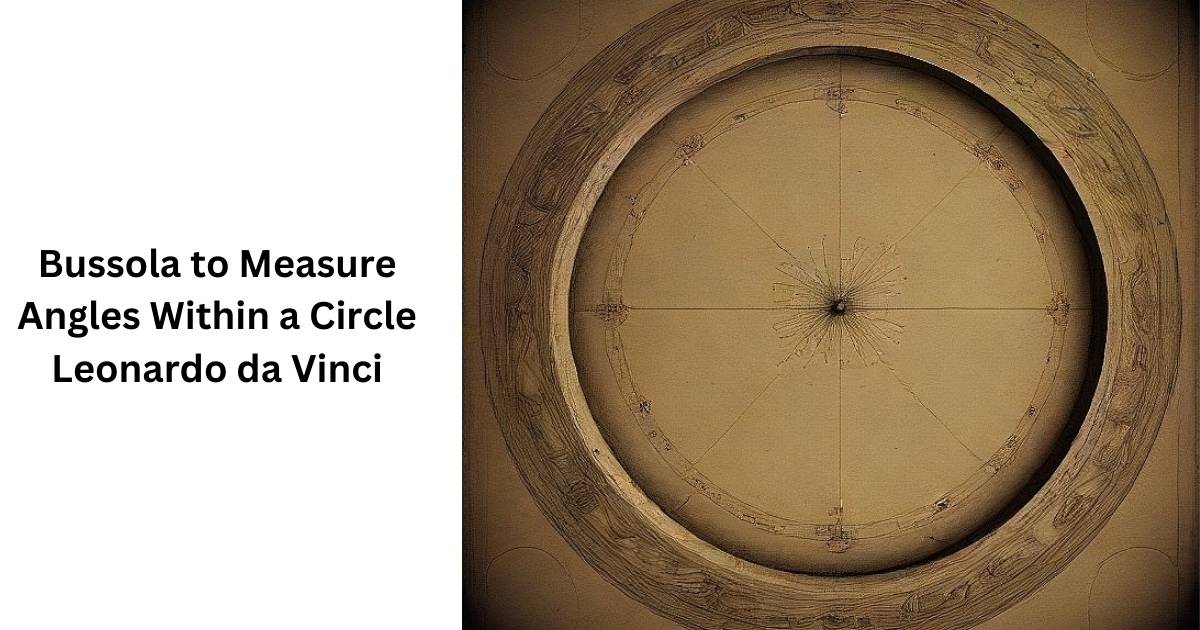Leonardo da Vinci, known for his masterpieces in art and pioneering inventions in engineering, also made significant contributions to the field of geometry. Among his many tools, the bussola to measure angles within a circle Leonardo da Vinci stands out as an essential instrument in his works. This simple yet effective tool played a crucial role in Da Vinci’s exploration of geometry, enhancing his ability to understand and manipulate the world around him. In this article, we’ll delve into how Leonardo used the bussola to measure angles within a circle Leonardo da Vinci to advance his studies in both art and science.
What Is the Bussola to Measure Angles Within a Circle Leonardo da Vinci?
The bussola to measure angles within a circle Leonardo da Vinci is an early precision instrument that allowed for the accurate measurement of angles. Though similar to a modern protractor, it was specifically designed to help Da Vinci’s detailed studies of geometry and mechanical design. Da Vinci’s bussola was used in his sketches, providing a way to measure and depict angles within circular forms, which were essential for many of his engineering projects.
This tool, also known as a “compass,” served as a critical device in Leonardo’s investigations into the geometry of circular shapes, arcs, and angles. Whether he was designing a machine, analyzing human anatomy, or creating one of his famous paintings, Da Vinci’s bussola to measure angles within a circle Leonardo da Vinci helped him achieve unparalleled accuracy in his work.
Leonardo da Vinci: The Renaissance Genius Behind the Bussola
Leonardo da Vinci lived during the Renaissance, a time when science, art, and engineering were flourishing. His passion for understanding the physical world through both observation and experimentation led him to create the bussola to measure angles within a circle Leonardo da Vinci. His inventive mind saw no boundaries between disciplines; he seamlessly integrated art, mathematics, and engineering to create some of the most revolutionary works of his time.
The bussola to measure angles within a circle Leonardo da Vinci was just one of many tools he developed to explore the mathematical underpinnings of nature. Da Vinci’s approach was grounded in the belief that understanding the laws of geometry and angles was essential for understanding the physical world and creating accurate designs.
How the Bussola to Measure Angles Within a Circle Leonardo da Vinci Was Used
The bussola to measure angles within a circle Leonardo da Vinci was an essential tool for creating precise geometrical designs. By measuring angles within circles, Da Vinci could create intricate designs for his inventions, like gears, mechanisms, and architectural structures. This was especially important for Da Vinci’s studies in mechanics, where the accurate measurement of angles was key to building working machines.
Whether he was designing a military engine or studying the flow of water in his hydraulic systems, the bussola to measure angles within a circle Leonardo da Vinci allowed him to measure and refine the angles of his designs. It was used in combination with other measuring tools, helping Da Vinci achieve the high level of accuracy required for his detailed and complex creations.
The Role of Geometry in Leonardo da Vinci’s Work
Geometry was a central theme in Leonardo da Vinci’s work. The bussola to measure angles within a circle Leonardo da Vinci was integral in understanding the relationships between different geometric shapes, especially circles. Da Vinci’s fascination with angles and proportions was evident in his art, where he applied these geometric principles to ensure that his works adhered to the most aesthetically pleasing and mathematically accurate ratios.
In addition to his art, geometry played a major role in Da Vinci’s mechanical designs. By measuring angles accurately, he could ensure that the components of his machines fit together perfectly, which was essential for functionality. The bussola to measure angles within a circle Leonardo da Vinci was indispensable in these applications, allowing him to bring his visionary designs to life.
Bussola to Measure Angles Within a Circle Leonardo da Vinci in Da Vinci’s Drawings
Many of Leonardo da Vinci’s sketches, including those of human anatomy, mechanical devices, and architectural plans, show the bussola to measure angles within a circle Leonardo da Vinci in action. These detailed drawings illustrate how the precise measurement of angles was critical to the design process.
For example, in his studies of the human body, Da Vinci used the bussola to measure angles within a circle Leonardo da Vinci to accurately depict the proportions of muscles, bones, and joints. Similarly, in his mechanical designs, he used the tool to create accurate angles for gears and levers, ensuring that these parts would function correctly when assembled.
How Da Vinci’s Innovation Inspired Future Generations
The bussola to measure angles within a circle Leonardo da Vinci was just one of many instruments Da Vinci used to advance the fields of science and engineering. His work inspired future generations of scientists, mathematicians, and engineers to continue exploring the world of geometry and mechanics. The tools and methods he developed, including the bussola to measure angles within a circle Leonardo da Vinci, laid the groundwork for later technological advancements.
Da Vinci’s commitment to accuracy and precision in measuring angles and proportions influenced countless innovators who came after him. Today, the principles he employed are still relevant, and his bussola to measure angles within a circle Leonardo da Vinci remains a symbol of his dedication to scientific exploration.
The Lasting Impact of Leonardo’s Bussola on Modern Science
Leonardo da Vinci’s bussola to measure angles within a circle Leonardo da Vinci may seem like a simple tool, but its impact on the fields of geometry, engineering, and art was profound. By developing instruments that allowed for precise measurements, Da Vinci set the stage for the development of modern scientific instruments and methods.
In many ways, Da Vinci’s approach to geometry, including his use of the bussola to measure angles within a circle Leonardo da Vinci, was ahead of its time. Today, we still rely on similar instruments to measure angles in various scientific and engineering applications, showcasing the enduring relevance of Da Vinci’s work.
Conclusion
Leonardo da Vinci’s bussola to measure angles within a circle Leonardo da Vinci was much more than a simple tool—it was a symbol of his brilliance and his ability to combine art and science in innovative ways. His use of this instrument allowed him to explore and create with an unmatched level of precision, helping him produce some of the most iconic works in history. Whether in his art, engineering designs, or scientific studies, Da Vinci’s understanding of geometry and angles, enhanced by the bussola to measure angles within a circle Leonardo da Vinci, was crucial to his success. His legacy continues to inspire generations of creators, proving that the tools we use today are built upon the foundations laid by pioneers like Da Vinci.
FAQs
What is the bussola to measure angles within a circle Leonardo da Vinci?
The bussola was a tool used by Leonardo da Vinci to measure angles within circles, aiding in his exploration of geometry and mechanical designs.
How did Leonardo da Vinci use the bussola to measure angles within a circle?
Da Vinci used the bussola in his studies of geometry and mechanical inventions, helping him create accurate angles for gears, machines, and even human anatomy.
Why was the bussola to measure angles within a circle important for Da Vinci?
It allowed Da Vinci to accurately measure and apply geometric principles to his art, designs, and inventions, ensuring precision in all his work.
How did the bussola influence Da Vinci’s art?
The precise measurements made possible by the bussola helped Da Vinci achieve perfect proportions in his paintings and drawings, particularly in the depiction of the human body.
Is the bussola still used today?
While modern tools have replaced the bussola, its fundamental principles still inform the geometric and engineering methods used today. Da Vinci’s innovative approach to measurement continues to inspire the scientific community.

